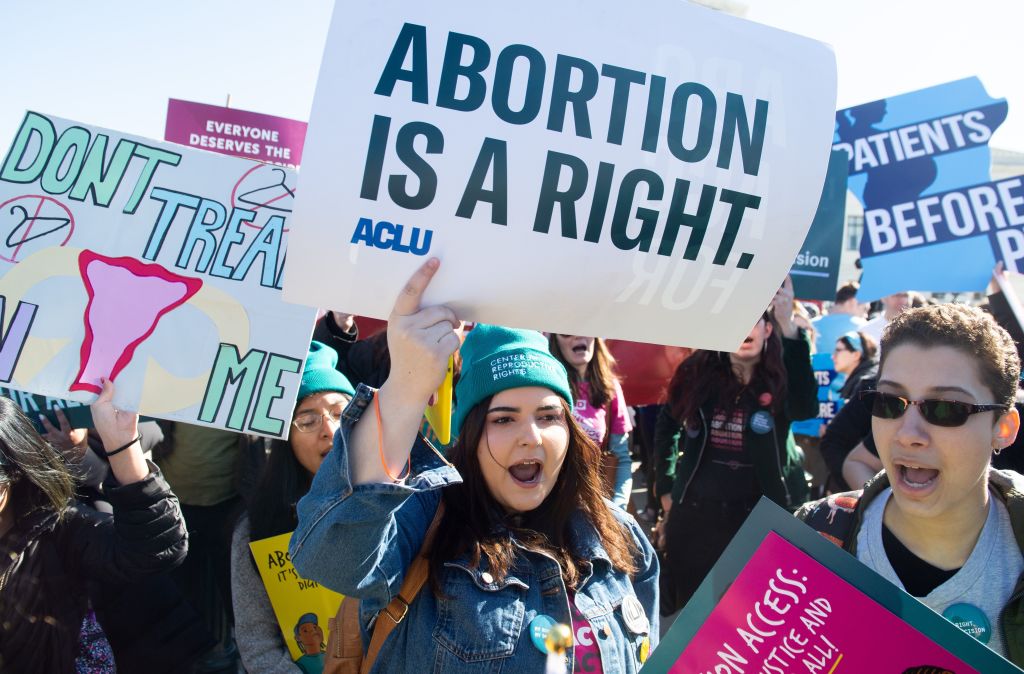Language, tactics used by anti-abortion movement called misinformation

The Texas law, SB 8, that bans abortion after six weeks in that state, is called “the Texas Heartbeat Act.”
But there is no heart within the pregnant person’s womb at six weeks after conception, according to health experts. At roughly six weeks, a current of electrical activity begins in a cellular cluster.
Abortion rights proponents argue that that is just one way that anti-abortion rhetoric supplies misinformation and disinformation. Anti-abortion groups also coopt the language of social justice movements, including the reproductive rights movement, reproductive rights advocates have said.
Adriann Barboa, policy director for the nonprofit organization Forward Together, said some who oppose coronavirus vaccinations and mask mandates use phrases such as, “my body, my choice,” when arguing against getting vaccinated or wearing masks to protect against COVID-19.
“People built that language [of social justice movements] coming out of slavery and forced sterilization and that’s not to say you have to go through something horrible to use it. But it hits the gut, thinking about those words being used to harm people’s health,” Barboa said.
Barboa said she has also heard anti-abortion activists rely on phrases from social justice movements such as “giving a voice for the voiceless” when arguing against abortion rights, saying that they are speaking on behalf of the fetus.
During the debate in New Mexico around SB10, the Respect New Mexico Women and Families Act, which eliminated antiquated language banning abortion that had been written into the New Mexico criminal code, Barboa said she heard a lot of anti-abortion critics say that removing that language, written in 1969, was “harming women.”
“I heard that more than ever before. For a long time, anti-abortion folks have been talking about mental health. This year they were really trying to plug into the ‘empower women’ speak,” she said.
Barboa also noted the phrase “sanctuaries for life,” which refer to municipalities or counties whose elected officials declare their communities “safe for the unborn.”
New Mexico counties that have declared themselves “sanctuaries for life,” include Eddy and Lea counties as well as the city of Roswell, which is in Chaves County. Eddy, Lea and Chaves counties are among 90 percent of counties across the U.S. that lack abortion clinics, according to Planned Parenthood Action Fund.
The anti-abortion politicians are using the language of immigrant rights groups by calling their political boundaries “sanctuaries,” Barboa said. But, anti-abortion groups tend to be anti-immigrant, she said.
Kristin Ford, NARAL Pro-Choice America’s acting vice president of communications and research, told NM Political Report that anti-abortion groups have said, recently, “babies’ lives matter,” which she called a “rip off” of Black Lives Matter.
“One of the things that’s so striking is really just the audacity, co-opting the language of feminism, human rights and social justice. It’s bold faced,” Ford said.
Janet Gotkin, a Santa Fe activist who has been involved in the reproductive rights movement since its early years, also brought up the concept of “fetal pain.”
“There’s a whole subset of people who believe a fetus feels pain,” she said.
According to the American College of Obstetrics and Gynecology, a fetus cannot experience pain until after viability. Intrauterine fetal movement does not indicate a fetus can feel pain, ACOG has said in a public statement.
“We need to unmoor that language and bring it back to the person who doesn’t want to be pregnant for whatever reason and who deserves health care and whatever care they need,” Gotkin said.
Behind the language
Laurie Bertram Roberts, executive director of the Yellowhammer Fund, a national abortion fund and reproductive justice organization based out of Alabama, said that for “those who are orchestrating this stuff, it has never been about babies and faith.”
“There’s always been a racial component. The same conservative circles [who talk about anti-abortion] are talking about replacement theory. One way to fight it is no access to abortion,” she said.
Joan Lamunyon Sanford, executive director of New Mexico Religious Coalition for Reproductive Choice, said the anti-abortion movement goes back to the years after the U.S. Supreme Court decision Brown v. Board of Education.
“Their leadership is modeling a culture against anyone who is not white, cisgender heterosexual male,” she said.
Ford said the history of the anti-abortion movement is an “undertold story.”
“What many people don’t understand is that some entities we really deeply associate with the anti-abortion movement, like the Southern Baptist Convention, supported reproductive freedom until they made an intentional pivot to stand against it as a political tool,” she said.
The Southern Baptist Convention did not respond to a request for comment.
Ford said abortion became a “weaponized issue” only after conservatives who supported school segregation in the 1960s realized that was no longer palatable an issue for most Americans.
But, she said, school segregation was the “original point of cohesion” for the early anti-abortion leadership.
A history of the language
Gotkin said the anti-abortion campaign gained traction when the leadership came up with the phrase “pro-life” in the 1980s.
“It was very powerful and it’s still powerful now,” she said, noting that the same political group is generally “pro-death penalty,” and against many policies that aid families such as Medicaid expansion, preschool funding and public fund increases for low-income families.
She called it “a public relations coup,” and said “I don’t think we’ve exactly recovered from it.”
“What it seems to say is ‘we are but you’re not.’ You care about silly things like choice. We care about life and they defined the argument for many years,” she said.
Crisis Pregnancy Centers
Reproductive rights experts call Crisis Pregnancy Centers, which are nonprofit in business model, “fake clinics,” because they are not health clinics. They are examples of disinformation, reproductive health experts have said.
Ellie Rushforth, an attorney with the American Civil Liberties Union of New Mexico, said there are over 30 of these centers in New Mexico and they are largely unregulated because they fall under nonprofit business status.
There are five abortion clinics serving the entire state. Because abortion clinics are health clinics, they are heavily regulated by both federal and state agencies, Rushforth said.
Rushforth said Crisis Pregnancy Centers (CPCs) are places of disinformation because their staff are largely volunteers, not medical professionals, but they often wear lab coats and offer services such as sonograms, pregnancy tests and Sexually Transmitted Disease tests for free. In places where there are abortion clinics, CPCs sometimes open up a facility next door and use signage that looks very similar to the neighboring abortion clinic, Rushforth said.
“They even refer to their ‘medical team,’ ‘medical staff or volunteers,’ or ‘mobile medical unit,’ which is a point of concern,” Rushforth said. “CPCs must follow anti-discrimination laws, tort laws, consumer protection laws. Whether enforcement of those duties happens is unclear.”
Barboa shared a story of when she was pregnant at the age of 16. She said she didn’t have the money for a pregnancy test, so she went to a CPC in the hope that it would help her.
She said the staff gave her a free pregnancy test, told her she was pregnant, then started talking to her about her Catholic faith. Barboa said she felt “trapped.”
“She [the CPC volunteer] was saying ‘what would Jesus do?’ I got on the bus, went back home. I left with brochures in hand. I asked more people and got the abortion care I wanted and needed at the time,” she said.
But, she said CPCs “prey” on people when they are at their most vulnerable.
Rushforth said there has been an “explosion” of crisis pregnancy centers in recent years because, as nonprofits, they receive private donations from wealthy donors but also, under former President Donald Trump, they received federal dollars under Title X family planning funding.
What the misinformation and disinformation accomplishes
When asked if the anti-abortion efforts in misinformation and disinformation succeed in preventing individuals from getting abortions, Bertrum Russell said “I think it sometimes confuses people.”
“Do I think it puts a huge dent in the number of people getting abortion? No. ‘We saved a baby today,’ they say on a website. They’ve harassed a person so bad they left and they came back the next week,” Bertram Russell said.
Ford made a connection between anti-abortion groups and politicians trying to block voting rights, which tend to harm communities of color the most, according to experts.
“There is a desire among anti-choice movement actors to cloak and confuse people about what their actual motivations are and what they want to accomplish. That’s where disinformation comes into play. They blatantly say false things. They’re trying to chip away at public support by muddying the waters, pedaling distortions and falsehoods around very personal decisions. They really can’t just say the unvarnished truth of what they want,” Ford said.
This article was originally posted on Language, tactics used by anti-abortion movement called misinformation







